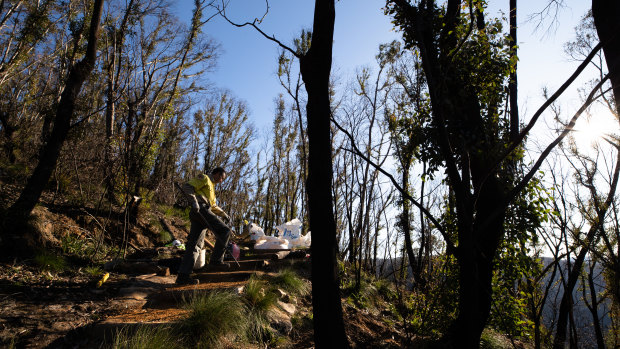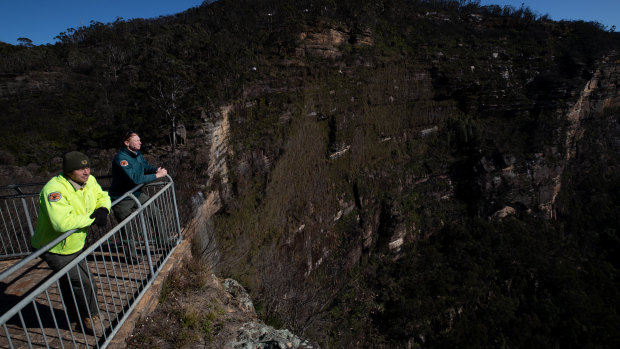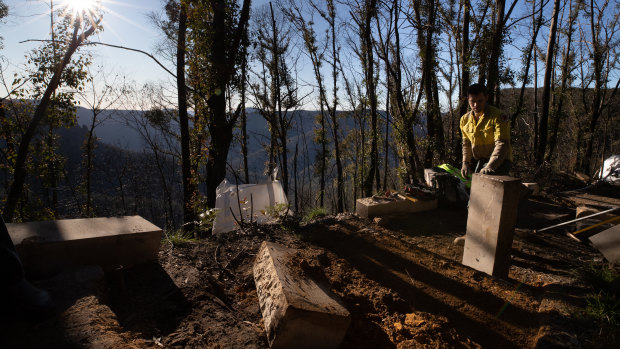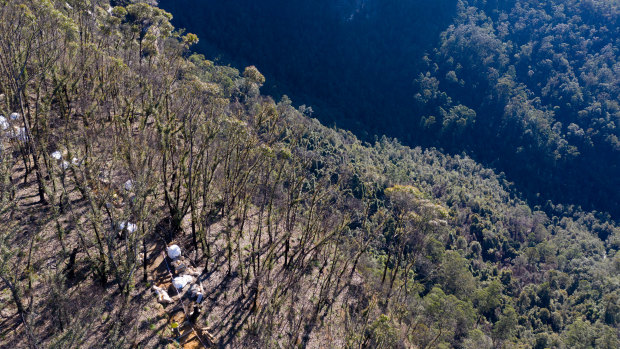As the morning sun creeps up the cliff and through the line of regenerating eucalypts, James Ridder recalls the well-worn joke about having the world's best office.
"You count it in the thousands," Mr Ridder says of the quip while he repairs the fire damaged Braeside walking track, metres from the deep drop over Govetts Leap in the Blue Mountains National Park.
Driving stakes into stone and hauling tonnes of masonry dropped in by air, he is part of a team crafting the trail for its 50,000 annual visitors.
According to David Crust, Blue Mountains director of the NSW National Parks and Wildlife Service, the job is an art form.
"A good bit of track looks like it's been there forever," Mr Crust says.
But since the summer bushfires wiped out 45 kilometres of hiking routes in the mountains alone - a situation compounded by landslides from downpours - a highly technical restoration effort has been under way to "future proof" tracks as more people turn to the outdoors for solace during the pandemic.

James Ridder repairs the fire-damaged Braeside walking track in the Blue Mountains.Credit: Janie Barrett
After the fires burned the wooden staircases NPWS replaced those fixtures on some of the more popular tracks with stone, which also helps with track stability by channelling water flow.
Helicopters lower half-tonne loads of sandstone every few metres, the pilots often relying on ground crews standing clear of the perilous down-draught to be their eyes.
Those on the ground, the firefighters and rope technicians, then move the 130 to 170-kilogram bricks into place by hand.
For areas where it is too dangerous for a helicopter to fly, a pulley system is used to move materials into their carefully chosen places.

Jon Darragh and Shaun Elwood from the NSW National Parks and Wildlife Service are working to upgrade fire-damaged walking tracks.Credit: Janie Barrett
"Everything is supposed to look natural as well as have a purpose," track worker Amy Child says as she landscapes earthen stonework along a bend to channel water flow.
Like the others, she is a national parks user herself and remains there from dawn to dusk.

Worker Brad Wright lays heavy sandstone bricks along the track near Blackheath.Credit: Janie Barrett
Supervisor Jon Darragh, who is heavily involved in the design of the trails, says the end product has taken into account the profile of visitors, demand, the track's heritage values, geotechnical features, and whether or not there are endangered species. Even the width of the bricks is intentional.
"Wide enough for people to walk and chat," Mr Darragh says.
Last year the state government poured $10 million into upgrading walking tracks between Wentworth Falls and Katoomba to improve access.
That's on top of roughly $1.2 million a year NPWS devotes to maintaining its Blue Mountains trails.
With foot traffic on popular Blue Mountains tracks soaring during the height of the lockdown, NPWS is aware of the impact the closure of trails has on the local economy.
While social media apps such as Instagram have intensified that popularity, they have also provided invaluable information for track design by showing where visitors are most likely to take photos.
"We're seeing a lot of changes to track use because of mobile phones," project manager Sean Elwood says, adding most of the issues are about managing safety.
Sociologists are even brought in to consult on creating natural barriers that are then incorporated into the design of the trails.

National Parks and Wildlife Service staff work metres from the cliff edge of Govetts Leap.Credit: Janie Barrett
"We fly in rocks to divert people on the tracks, to divert people from danger. There's a lot of psychology in it," Mr Elwood said.
"A lot of visitors just take it for granted: a walking track's just a walking track."
Get our Morning & Evening Edition newsletters
The most important news, analysis and insights delivered to your inbox at the start and end of each day. Sign up to The Sydney Morning Herald’s newsletter here, to The Age’s newsletter here and Brisbane Times' here.